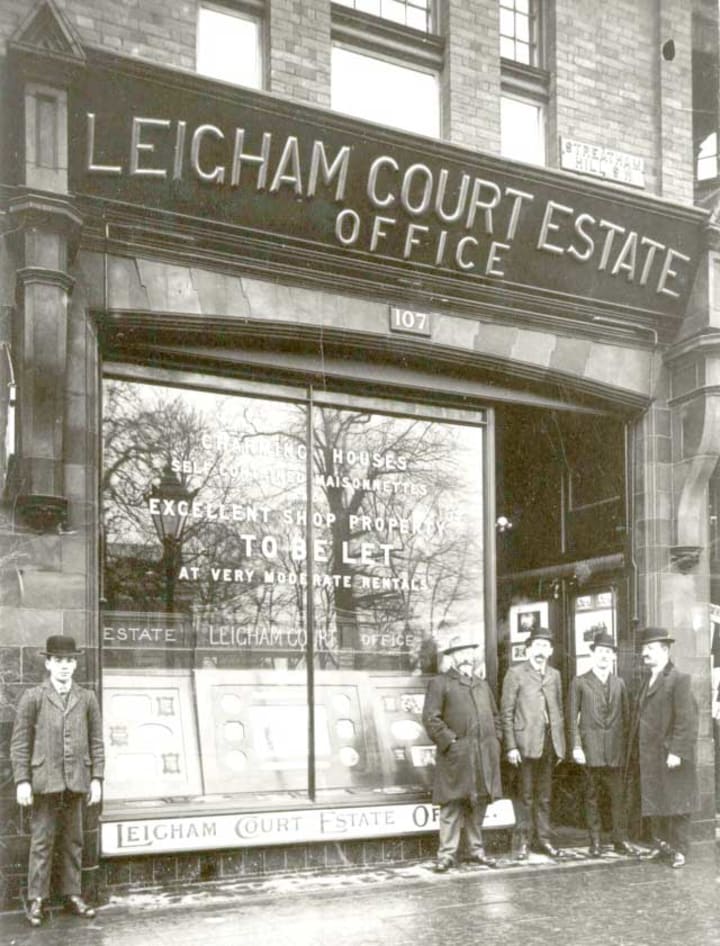This Is The Amazing Transformation Of An Important Roman Trackway
Streatham high road (and its traffic) have shaped Streatham's development.

Streatham High Road is one of capital major arterial roads. From Roman times, and after their departure, the principal road through Streatham remained a significant trackway. From the 17th century, it was used as the primary coach road to Croydon and East Grinstead, after on to Newhaven and Lewes. In 1780 it became the route of the turnpike road from London to Brighton, and subsequently became the basis for the modern A23.
The new and enhanced local services and facilities encouraged planning additional residential and commercial developments in the area. These were conceived throughout the mid-1870s and the following decades. Streatham high road (and its traffic) have shaped Streatham's development.

The population of Streatham increased from about 400 in 1725 to 2,357 recorded in the 1801 census, and by 1831 it was 5,000.
The opening of Streatham Hill railway Station in 1856 and Streatham Station in 1868 gave easy access to those who worked in the city.
The old estates and their vast grounds came under obligation to be developed, and many were broken up and sold off for building.
This development stretched into the early part of the twentieth century when the green avenues and open spaces, the flourishing retail centre, the new transports and the opening of theatres, cinemas and dance halls made Streatham a trendy address.

Streatham drew in the new middle classes, including doctors, architects, managers, teachers, music and variety entertainers. Streatham reflects the significant social, economic and architectural changes that occurred throughout the second half of the 19th century and the first half of the 20th century. By 1871 Streatham population had grown to 12,000 and 71,000 by 1901.
Streatham Village
The village continued mostly unaltered until the 18th century, when its natural springs, known as Streatham Wells, were first celebrated for their health-giving qualities.

The good name of the spa, and improved turnpike roads, brought wealthy City of London merchants and business people to build their country homes in Streatham.
After 1840, the High Road between Streatham Hill Station and Streatham village was rapidly transformed. Along this stretch of the road, some large mansion properties were built.
Norfolk House, de Monfort House and Broadlands, all set back from the road and filling spacious and well laid out grounds, were among these grand properties.
Cable cars tram was introduced between Brixton and Streatham Hill tram depot in 1892. From 1895 the line was extended, and the Streatham Tate Library became the London and Brixton tram terminus.

The tramway was further expanded in 1909 to connect central London and Croydon. Trams stopped operating through Streatham on 7th April 1951.
Today there is still some evidence of Streatham old village centre surrounded by fields. Principally the remaining portion of the village green and the Victorian Gothic drinking fountain (1862), which was created by the artist and resident William Dyce, St. Leonard's Parish Church and some surviving Georgian properties to the northeast of the Church.
Roupell Park
Among the first, generously sized development, was Roupell Park, the area near Christchurch Road promoted by the Roupell family.
Commencing in the 1840s, the family planned and completed Roupell Park, a prestigious and ambitious construction concentrated on Christchurch and Palace Roads, Streatham Hill.
The estate, designed to attract the wealthy, contained some of the largest homes yet to be seen in Streatham. Development was completed in the late 1880s when building began towards Tulse Hill.
With Roupell Park, north Streatham had almost acquired its own identity.
Other streets took a more conventional suburban layout. To serve the growing area, three additional parish churches were built, including Immanuel and St Andrew's (1854), St Peter's (1870) and St Margaret the Queen's (1889).

Now Streatham has a mixture of buildings from all architectural periods of the last 200 years.
The Development of Suburban Estates
From 1880 to 1914 Streatham experienced the full effect of London suburban development.
During this period, Streatham, and much of the outer London area, appeared as one large building site as thousands of buildings of a different type, style, and social basis were built.
Telford Park Estate
The developer used the latest innovations in social and town planning to attract prospective tenants to their new properties, and to some extent, promoted free expression in urban design and style. Telford Park, Streatham Hill was the first estate of this kind, developed by Sutton and Dudley from 1878.

Once the estate was completed, the properties were marketed as "modern homes." Rents varied from £50 to £500 a year or were available from £500 for sale. Its street pattern, as well as a typical building line, the layout of this development, set a model for developments in Streatham's estate.
Several large projects followed Telford Park.
The housing estates built in this period, like Coventry Park (1880s), Manor Park (1880s), Bedford Park (1880s), Norfolk House (1900s) and Streatham Lodge (1900s), have contributed to the identity and history of Streatham.
Coventry Park Estate
The building of Coventry Park Estate (Streatham Common), can be considered as an example of late-Victorian estate development. It took place from 1878 when plots were put up for sale.
The vendors laid out several roads and a footpath to provide ready access from the building plots to the station. The proximity of the common was said to provide prospective tenants with an open area for "health and leisure purposes."
The type of dwellings developed were large semi-detached or detached homes, especially for the middle and upper income groups: those who had the ability to keep maids and workers within the house.
The choice of rental accommodation was limited for the less well off. For this group, house building was reserved to a street or two of terraced or cottage-type properties.
Further housing was built from the late 1890s.
During the two decades leading to World War 1 Streatham had continuous suburban and commercial building.
Furzedown
Furzedown was among the last remaining areas awaiting development. Construction here started during the latter years of the 1900s and continued well into the years after World War I. The land was originally part of Furzedown House, an elegant villa that was built in 1794 and was home to many prominent citizens.
Parkland was partly used as a public open area, and the golf course used by the Tooting Bec Golf Club, founded in 1888. Furzedown House become part of Furzedown Teachers Training College, opened by London County Council in 1915.
Leigham Court Estate
In Streatham Hill, the large country estate of 66 acres was developed. This is Leigham Court. The development of this site was undertaken by the Artizans', Labourers' and General Dwellings Company. The developer provided social housing, building good quality homes at reasonable rents. The company purchased the estate during the late 1880s.

Constructions began laying out Mesbury, Barcombe and Cricklade Avenues, and by 1894 the first resident moved into the new houses.
Construction continued at some pace with the bulk of the estate being completed during the mid-1900s. Rents started from £30 to £60 per year for the houses and from £20 to £40 for the maisonettes.
Leigham Court estate was made conservation area by Lambeth Borough Council in 1981.
The estate was completed in the late 1920s

In this period F. T. Wooding and Sons, were selling the semi-detached houses on Leigham estate at starting price of £975. These properties were slightly less than similar properties built close by. On the Kirkstall Road Estate at Telford Avenue, houses were available starting from £995.
Shopping Facilities
Streatham's newest shopping centre began to take shape from the late 1870s, when it redeveloped the High Road between Streatham Station and St. Leonard's church.
The main shopping centre for Streatham was previously situated in Bedford Street, a series of "picturesque "- looking properties from the 17th and 18th centuries on the road opposite Streatham Green. William Reynolds owned his linen drapers store in one of these buildings, and where George Pratt-the founder of Streatham's largest retailer, Pratt's Department Store-was worked as an assistant.

Prior to suburban development there were also other small shopping areas in Streatham. On the highways at Streatham Common and at South Streatham, clusters of small service shops such as bakers, drapers, shoemakers etc.
On Streatham Hill, Streatham Place and New Park Road, small cottage style outlets were built during the 1820s and 1830s, with the opening of a new pub, The Cross-in-Hand, almost at the same time of The Crown and Sceptre on Streatham Hill.
Streatham High rd was completed during the 1930s. In the Victorian and Edwardian style retails included various shopping "parades" with flats above.
One of the main developments was The High.
Okay, Streatham High Road was voted worst high street in the UK. That was the result of a Radio 4 poll, its broader demographic perhaps isn’t so keen high streets full of chicken shops and Asian mini-markets. But also that was in 2002, and London moves fast that many areas are unrecognisable after a few years, you can just imagine in nearly twenty years.
There are now a number of new bars, cafes and restaurants, mirroring the sprinkling of its residents.
From West African to Indian restaurants. Chinese, Lebanese, Japanese, Vietnamese, Spanish and good old British food.
Streatham is in that glorious middle stage of 'poshing up', but it’s still very much ‘real’, whatever it means.
Streatham played a central role in the long and important history of London. Streatham has a proud history of welcoming people from across the world, and many different backgrounds and one of the most integrated places in Europe.
About the Creator
Anton Black
I write about politics, society and the city where I live: London in the UK.






Comments
There are no comments for this story
Be the first to respond and start the conversation.